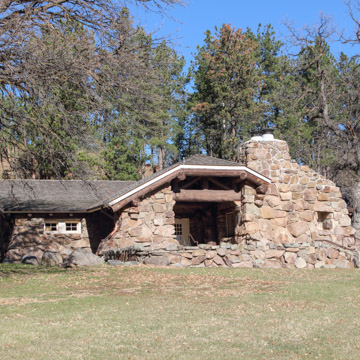You are here
Peter Norbeck Outdoor Education Center
The Peter Norbeck Outdoor Education Center, located in South Dakota’s Black Hills, is an excellent example of the Rustic architecture endorsed by the National Park Service (NPS) during the Great Depression. The building, designed by Sioux Falls architect Harold Spitznagel, was praised in a 1938 NPS publication for its “rugged, vigorous, and informal character.” The use of indigenous materials, such as uncut boulders and natural finishes, was employed by Spitznagel in several other New Deal–era structures, including the nearby Sylvan Lake Lodge (1937).
Constructed by the Civilian Conservation Corps between 1934 and 1936, the small, one-story building is notable for its heavy, uncut boulders that form the foundation and walls. These stone walls flare at the base and, combined with the shallow-pitched jerkinhead roof, firmly root the building to the earth. The roof’s exposed log rafter tails continue on the interior as round log beams. The front entrance is recessed behind a stone porch that is nearly dwarfed by an adjacent stone fireplace. In the 1990s, a similarly styled addition was built on the east end of the building.
The structure originally contained a museum showcasing Custer State Park’s history, and also served as a visitors’ center. As visitor numbers increased over the years, the demand for a larger facility resulted in the May 2016 opening of a new visitors’ center one mile east. Following renovations, this building re-opened in 2017 as the Norbeck Outdoor Education Center, offering refurbished exhibits on the park’s and region’s natural history including wildlife, mining, forestry, geology, and hydrology, as well as educational programs for children that focus on the natural environment.
References
Writing Credits
If SAH Archipedia has been useful to you, please consider supporting it.
SAH Archipedia tells the story of the United States through its buildings, landscapes, and cities. This freely available resource empowers the public with authoritative knowledge that deepens their understanding and appreciation of the built environment. But the Society of Architectural Historians, which created SAH Archipedia with University of Virginia Press, needs your support to maintain the high-caliber research, writing, photography, cartography, editing, design, and programming that make SAH Archipedia a trusted online resource available to all who value the history of place, heritage tourism, and learning.














